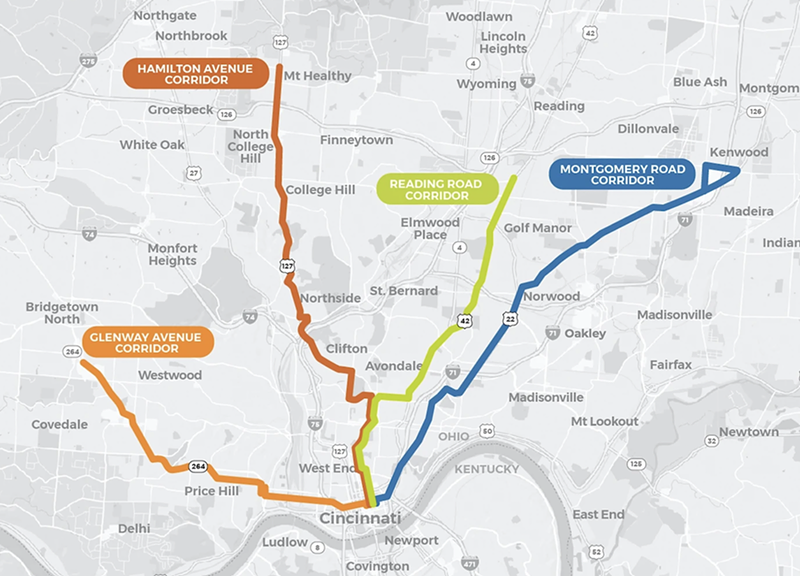Photo: Nick Swartsell
SORTA and Metro are conducting a study by March 2023 to determine which bus rapid transit corridors will have the greatest impact on ridership.
Metro Cincinnati presented four possible options for new bus rapid transit corridors that the agency says will allow riders to travel faster than ever.
Brandy Jones, Metro’s senior vice president of external affairs, says there’s a big difference between a regular city bus and a bus rapid transit (BRT).
“The closest comparison is if you’re familiar with rail,” says Jones. “It’s faster down the corridor, there’s off-board pay, it’s a lot more compelling to go a long distance, but it has the flexibility of a rubber tire.”
Jones says BRT is more like a train than a bus because of how rarely it stops for both passengers and traffic lights.
“Unlike a traditional bus route, where you’re likely to see a bus stop every block, every other block, the BRT corridor has far fewer stops. They will have very specific locations where they will correlate with the most potential number of passengers boarding.”
As more passengers board the BRT at the same time, they will pay for their fares in advance, speeding up the process. Although there will be fewer stops, Jones says riders can expect a BRT bus to arrive every 10 to 15 minutes.
Another BRT difference that speeds up the route is signal priority.
“If the traffic signal indicates that a BRT bus is coming—say, there’s a green light—it will stay green longer to allow the bus to pass through the corridor, or simply give the bus the right of way so you don’t get stopped at as many lights as you would in a car.” – says Jones. “In some ways, you can travel down the corridor faster than you can in a private car.”
Metro says riders can expect other rail-like qualities from BRT buses:
- Station stops are more widely spaced than traditional bus routes
- Attractive, clean, comfortable stations
- Buses with Wi-Fi and charging ports
- Bus arrival tables in real time
- Fully accessible stations with bus entrance on the same level
- Boarding and exiting through any door
Potential for economic growth
Metro has proposed four possible options for BRT routes to launch sometime in 2027: Glenway Avenue, Hamilton Avenue, Reading Road and Montgomery Road. Only two will be implemented at first.

Photo: Cincinnati Metro
Metro proposed four possible options for rapid bus routes: Glenway Avenue, Hamilton Avenue, Reading Road and Montgomery Road.
Metro says the four corridors represent the most popular transit routes, each carrying more than a million passengers annually.
The Southwest Ohio Regional Transportation Authority (SORTA) and Metro are conducting a research through March to determine which fast corridors will have the greatest impact on its participants.
“We’ve already determined that each corridor has some aspect of this, but it’s important which two will have the biggest impact,” says Jones.
Currently, funding is only available for two corridors, but Meta says it’s possible BRT will eventually expand to all four corridors. At this point, it’s about determining where the greatest need can be met.
The study will assess the ability of each corridor to atract of horsemen, iincrease the speed of transit and communicationprovide fairer access, ssupporting the installation and operation of BRT infrastructure, and ssupport economic development opportunities, says Metro. The agency uses ridership data, economic development information and public feedback to guide the study of each corridor.
Any BRT corridor would need its own dedicated bus lane to enable the speed and efficiency of the rapid route. Jones says Metro will need to determine which two corridors out of four candidates will have the best chance of either repurposing the traffic lane or building a new dedicated BRT lane.
Jones says riders and businesses also take economic considerations into account when choosing which areas to get bus rapid transit.
“Where do companies want to build? Where are construction companies looking to add new housing developments, businesses or services? We also look at it through an economic development lens,” says Jones.
How to participate
Metro is asking those who live near a potential BRT route and those who are invested in implementing a particular route to participate in the study.
“We don’t want it to be just metrics and numbers and data,” says Jones. “It’s all very important, but we want to humanize it. How will it help people along this corridor. This feedback will be crucial as the research progresses.”
In addition to the online survey, Metro will collect personal feedback on the proposed BRT routes during a series of public hearings:
- Oct. 3, Community Action Agency, 1740 Langdon Farm Rd., 4-7 p.m
- Oct. 11, Avondale Branch Library, 3566 Reading Rd., 5:30-7:30 p.m.
- Oct. 12 at the Evanston Recreation Center, 3204 Woodburn Ave. 5:30-7:30 p.m
- Oct. 13 Price Hill Branch Library, 970 Purcell Ave., 4-7 p.m
- Oct. 17 College Hill Recreation Center, 5545 Belmont Ave., 4:30-7:30 p.m.
- October 18, virtual meeting, 12:00 – 14:00
- October 18, virtual meeting, 5-7 p.m
- Oct. 19, Clifton United Methodist Church, 3416 Clifton Ave., 4:30-6:30 p.m.
Jones says the public meetings are an open house, so members can come at their convenience.
https://www.citybeat.com/news/give-feedback-on-metros-proposed-bus-rapid-transit-brt-corridors-13959897



